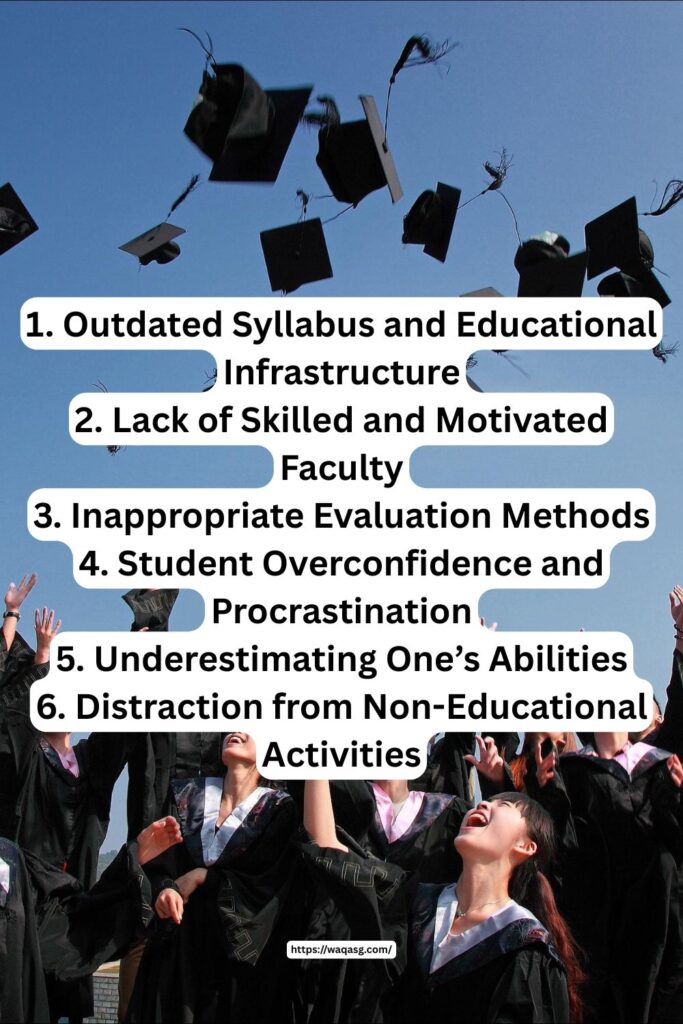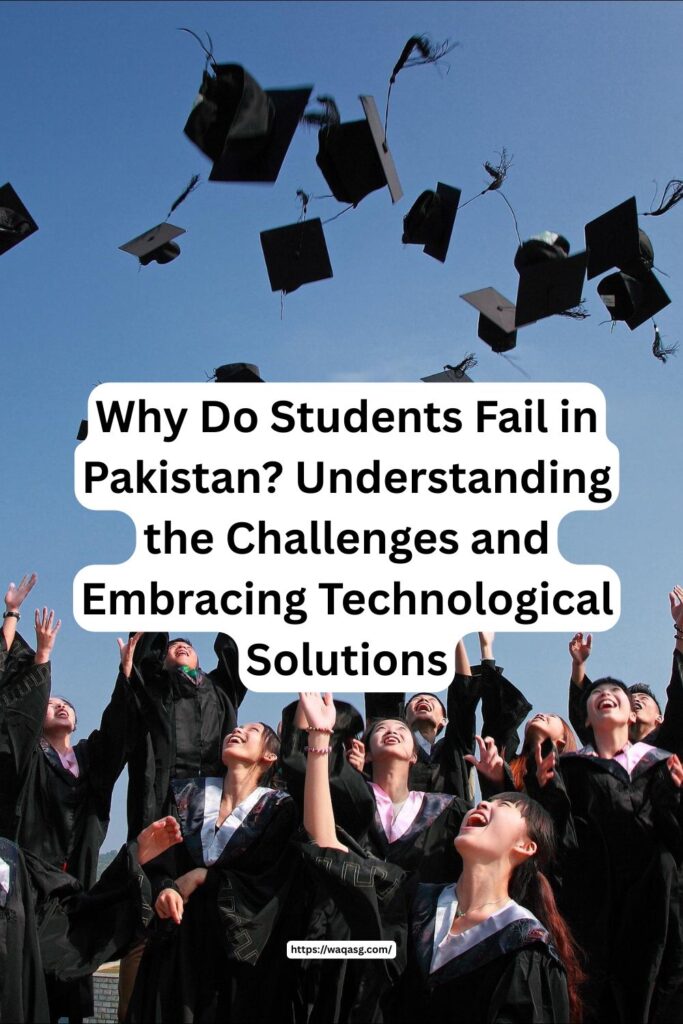
Why Do Students Fail in Pakistan? Understanding the Challenges and Embracing Technological Solutions
Originally published in August 24, 2019. Last updated on April 15, 2025
Education is the cornerstone of human development, societal advancement, and economic growth. However, in Pakistan, just like anywhere else in the world, education is considered crucial to individual success and the nation’s prosperity. Despite recognizing its importance, many students in Pakistan still face academic challenges. This results as a failure. Instead of directly blaming students. We, (teachers, faculty members and parents) must examine broader, deeper factors that contribute to these failures.
In this article, I’ll explore the primary reasons why students fail academically in Pakistan. And how these problems affect students’ growth, and most importantly, in addition to that how technology can help solve these issues optimistically and constructively.
1. Outdated Syllabus and Educational Infrastructure
One major issue in Pakistan’s education system is an obsolete and outdated syllabus. Everything in the modern world constantly evolves, whether it is technology, or culture, or even the economy. Unfortunately, educational curricula in Pakistan have remained largely unchanged for decades. Due to that in order to keep pace with global standards and current industry demands.
A syllabus stuck in the past significantly affects the students’ learning outcomes and reduces their competitiveness in the job market. Contrary to that the modern careers require students to have updated skills, advanced knowledge, and familiarity with current trends. And the Pakistan’s educational authorities such as text book boards, need to urgently revamp the syllabus to align it with the modern, tech-driven world.
How Technology Can Help
Digital platforms, online courses, and updated e-learning tools can bridge the gap between the so-called outdated syllabus and current industry needs. Nowadays, platforms like Coursera, Khan Academy, or even local online initiatives provide updated resources in science, technology, mathematics, and the humanities. By incorporating these resources into the regular curriculum, the students can remain competitive and prepared for future unforeseen challenges.

2. Lack of Skilled and Motivated Faculty
Another fundamental challenge contributing to student failure in Pakistan is the lack of qualified and motivated teachers. Teachers play a vital role in a student’s academic journey. Unfortunately, the recruitment processes in Pakistan often fail to select teachers based purely on merit. Due to these reasons, results in less-skilled teachers unable to effectively guide students or inspire a passion for learning.
Sometimes, teachers unknowingly discourage students through constant criticism, undermining students’ self-confidence and causing long-term harm to their motivation and mental health. Albert Einstein once insightfully remarked, “Everybody is a genius. But if you judge a fish by its ability to climb a tree, it will live its whole life believing it is stupid.” Thus, the role of teachers should be supportive and adaptive, recognizing each student’s unique strengths rather than highlighting only their weaknesses.
Leveraging Technology for Better Teaching
Technology can significantly enhance teaching standards by providing professional training and resources for teachers. Online platforms offering teacher training programs can equip educators with modern pedagogical techniques, digital tools, and effective communication skills. Integrating technology into the teaching process encourages creativity, boosts motivation, and improves overall educational quality.
3. Inappropriate Evaluation Methods
Traditional examination methods often fail to measure students’ true abilities effectively. Exams in Pakistan typically focus on rote memorization rather than analytical skills, creativity, or practical application. This evaluation method leaves students unprepared for real-world challenges and often contributes to academic failure.
Students with talents in arts, creativity, sports, or critical thinking may suffer under this evaluation system. Exams that emphasize only memorization and repetition discourage talented students who excel in practical or creative fields but struggle with rote learning.
Technology-Driven Assessment Solutions
Digital assessment tools and technology-enabled testing can transform evaluation methods by measuring multiple intelligences, creativity, analytical abilities, and practical skills. Educational institutions should integrate platforms offering diverse assessment methods, including project-based assessments, online quizzes, and interactive learning apps, to effectively evaluate every student’s unique strengths.
4. Student Overconfidence and Procrastination
A lot of students in Pakistan fail due to overconfidence. Some students believe they can excel academically by last-minute studying, which is commonly referred to as the “Chand Raat” approach. While it sometimes works for short-term results, such practices inevitably lead to shallow knowledge, which leads to poor long-term retention and weak foundations.
Such students, even if passing, may later become economically unproductive because they never truly mastered important skills. Procrastination and overconfidence hinder their ability to become competitive professionals.
Tackling Procrastination with Technology
Technology offers effective solutions to address procrastination and encourage consistency. Apps like Google Calendar, Trello, and productivity tools such as Todoist help students set goals, manage their time, and maintain organized study schedules. By embracing digital planners and task management tools, students can significantly improve their time management and productivity, promoting better long-term results.

5. Underestimating One’s Abilities
Conversely, some students fail because they underestimate their abilities. They lack confidence in their skills, which leads to psychological issues such as anxiety, depression, and low self-esteem. Over time, these negative feelings become self-fulfilling prophecies, severely limiting their academic performance and potential success.
Building Confidence Through Technology
Technology again offers optimistic solutions. Online learning platforms and interactive apps create a low-pressure environment where students learn at their own pace without fear of judgment or failure. Interactive quizzes, adaptive learning software, and gamified learning experiences help students build confidence and strengthen their abilities step-by-step, reducing anxiety and improving self-esteem.
6. Distraction from Non-Educational Activities
Engagement in excessive non-academic or co-curricular activities can negatively affect students’ performance. Students sometimes spend excessive time in gaming, social media, and other distracting activities, neglecting their academic responsibilities. While extracurricular activities are valuable, overindulgence without balance often results in academic underperformance.
Balanced Learning through Technology
To address this, technology can offer balanced solutions through structured schedules and digital parental controls. Educational apps and digital platforms provide engaging educational content that attracts students’ attention constructively, bridging the gap between entertainment and productive learning. This approach makes studying more enjoyable and prevents students from becoming overwhelmed by irrelevant activities.
Optimistic Outlook: Transforming Pakistani Education through Technology
Despite these challenges, optimism is warranted due to the transformative potential of technology in education. Technology-based learning solutions promise significant improvements in Pakistan’s educational standards, addressing syllabus gaps, enhancing teacher quality, providing better evaluation methods, and positively influencing students’ academic habits.
The rise of digital learning platforms and educational technology startups in Pakistan illustrates a vibrant ecosystem ready to enhance educational standards. Collaboration between educational institutions, technology providers, and policymakers can foster an environment where technology effectively transforms traditional learning methods.
Conclusion: An Opportunity for Growth
Student failure in Pakistan isn’t merely about individual shortcomings. It’s also a reflection of systemic issues, outdated methods, inadequate teaching, and poor support systems. Instead of placing blame solely on students, it’s crucial to adopt a holistic view—identifying challenges and finding practical, optimistic solutions through technology.
By integrating technology into education, we can provide students with quality learning experiences, updated curricula, skilled educators, balanced lifestyles, and appropriate evaluation systems. Pakistani students deserve education that reflects their true potential and prepares them to thrive in a dynamic world.
With optimism, strategic technology use, and committed improvements, student failure can become a rarity rather than a common occurrence. The journey toward educational excellence is not just achievable—it’s already underway, driven by technology and a collective desire to create a brighter, empowered future for students in Pakistan.





No comment yet, add your voice below!